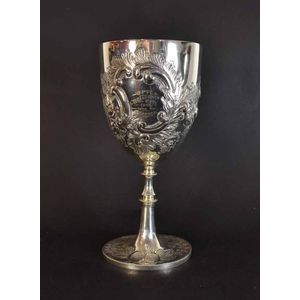Victorian Silver Liqueur Chalice with Naturalistic Form
You must be a subscriber, and be logged in to view price and dealer details.
Subscribe Now to view actual auction price for this item
When you subscribe, you have the option of setting the currency in which to display prices to $Au, $US, $NZ or Stg.
- Chalice - A chalice is a large cup or goblet that is used in religious ceremonies, particularly in Christian liturgical traditions. It is typically made of precious metal such as gold or silver, and is used to hold wine during the Eucharist, which is the central sacrament of the Christian Church. The chalice is also called the "cup of salvation" and is a symbol of Jesus' sacrifice on the cross.
In the Christian tradition, the chalice is a symbol of the blood of Jesus Christ, which is offered to the faithful as a means of grace and salvation. The chalice is used to hold the wine that is consecrated during the Eucharist and is considered to be a sacred object.
In the liturgical celebration of the Eucharist, it's passed around to the faithful, and the believer drinks from it to partake in the sacrament. Chalices are also used in other liturgical celebrations such as baptism, confirmation and anointing of the sick.
Chalices come in different shapes and sizes, from simple cups to highly ornate and decorative vessels, some of them are adorned with precious stones and intricate engravings. Chalices can also be used for other purposes, such as for holding holy water for baptism, or for the distribution of ashes on Ash Wednesday. - Victorian Period - The Victorian period of furniture and decorative arts design covers the reign of Queen Victoria from 1837 to 1901. There was not one dominant style of furniture in the Victorian period. Designers used and modified many historical styles such as Gothic, Tudor, Elizabethan, English Rococo, Neoclassical and others, although use of some styles, such as English Rococo and Gothic tended to dominate the furniture manufacture of the period.
The Victorian period was preceded by the Regency and William IV periods, and followed by the Edwardian period, named for Edward VII (1841 ? 1910) who was King of the United Kingdom and the British Dominions and Emperor of India for the brief period from 1901 until his death in 1910. - Sterling Silver - Sterling silver is a mixture of 92.5% pure silver and 7.5% of another metal, usually copper. Fine silver is 99.9% pure silver, and is relatively soft and the addition of the very small amount of copper gives the metal enough strength and hardness to be worked into jewellery, decorative and household objects.
This item has been included into following indexes:
Visually similar items

A George III silver goblet, the ovoid bowl with the lower half swollen fluted, raised on a tapering stem from a circular foot with gadroon border. London 1812 possibly by Joseph Biggs. Weight 229gms. Height 15.5 cm

Important Victorian sterling silver trophy bowl with embossed racing scene, hallmarked and stamped W.E. for the maker William Edwards, Melbourne c.1865

A West Australian Royal Perth yacht club racing trophy engraved 'R.P.Y.C. Commodores cup 1909 Won by Banshee'. The trophy is silver plated with retailers mark 'Stewart Dawson & Co'. Height 24 cm. Note: the Banshee also has a dark chapter including a tragic

An Indian silver measuring spirit measure.
